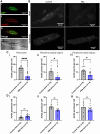Atrial granules as acidic calcium stores in cardiomyocytes
- PMID: 40704328
- PMCID: PMC12284475
- DOI: 10.1093/ehjopen/oeaf083
Atrial granules as acidic calcium stores in cardiomyocytes
Abstract
Acidic calcium stores significantly influence basal calcium transient amplitude and β-adrenergic responses in cardiomyocytes. Atrial myocytes contain atrial granules (AGs), small acidic organelles that store and secrete atrial natriuretic peptide (ANP) and are absent in healthy ventricular myocytes. AGs are known to be acidic and calcium-rich, but their number and location relative to other signalling sites remain unexplored. Labelling of acidic organelles in adult guinea pig cardiomyocytes showed the presence of acidic puncta throughout the cytosol. Atrial myocytes exhibited an increased concentration of acidic organelles at the nuclear poles. Live cell fluorescent studies using 4-phenyl-3-butenoic acid (PBA) to inhibit peptidylglycine α-amidating monooxygenase, a crucial component of AGs membranes, effectively eliminated staining at the nuclear poles and most acidic puncta in atrial cells, but not in ventricular cells. Our immunofluorescent labelling also emphasizes the differences in acidic punctae between atrial and ventricular myocytes by showing minimal co-localization between AG-specific ANP and lysosomal-associated membrane protein. Electron microscopy studies on goat atrial fibrillation (AF) and sham control tissue allowed visualization of AGs. Quantitative analysis revealed that AGs were positioned significantly further away from the nearest sarcoplasmic reticulum and were closer to mitochondria in AF compared to sinus rhythm control tissue. We raise the question whether the positioning of AGs is strategic for communication with other calcium-containing organelles.
Keywords: Atrial fibrillation; Atrial granules; Cardiomyocytes; Electron microscopy; PAM.
© The Author(s) 2025. Published by Oxford University Press on behalf of the European Society of Cardiology.
Conflict of interest statement
Conflict of interest: None to declare.
Figures


References
-
- Collins TP, Bayliss R, Churchill GC, Galione A, Terrar DA. NAADP influences excitation-contraction coupling by releasing calcium from lysosomes in atrial myocytes. Cell Calcium 2011;50:449–458. - PubMed
-
- Capel RA, Bolton EL, Lin WK, Aston D, Wang Y, Liu W, Wang X, Burton R-AB, Bloor-Young D, Shade K-T, Ruas M, Parrington J, Churchill GC, Lei M, Galione A, Terrar DA. Two-pore channels (TPC2s) and nicotinic acid adenine dinucleotide phosphate (NAADP) at lysosomal-sarcoplasmic reticular junctions contribute to acute and chronic β-adrenoceptor signaling in the heart. J Biol Chem 2015;290:30087–30098. - PMC - PubMed
-
- Cantin M, Genest J. The heart as an endocrine gland. Sci Am 1986;254:76–81. - PubMed
LinkOut - more resources
Full Text Sources
Miscellaneous

